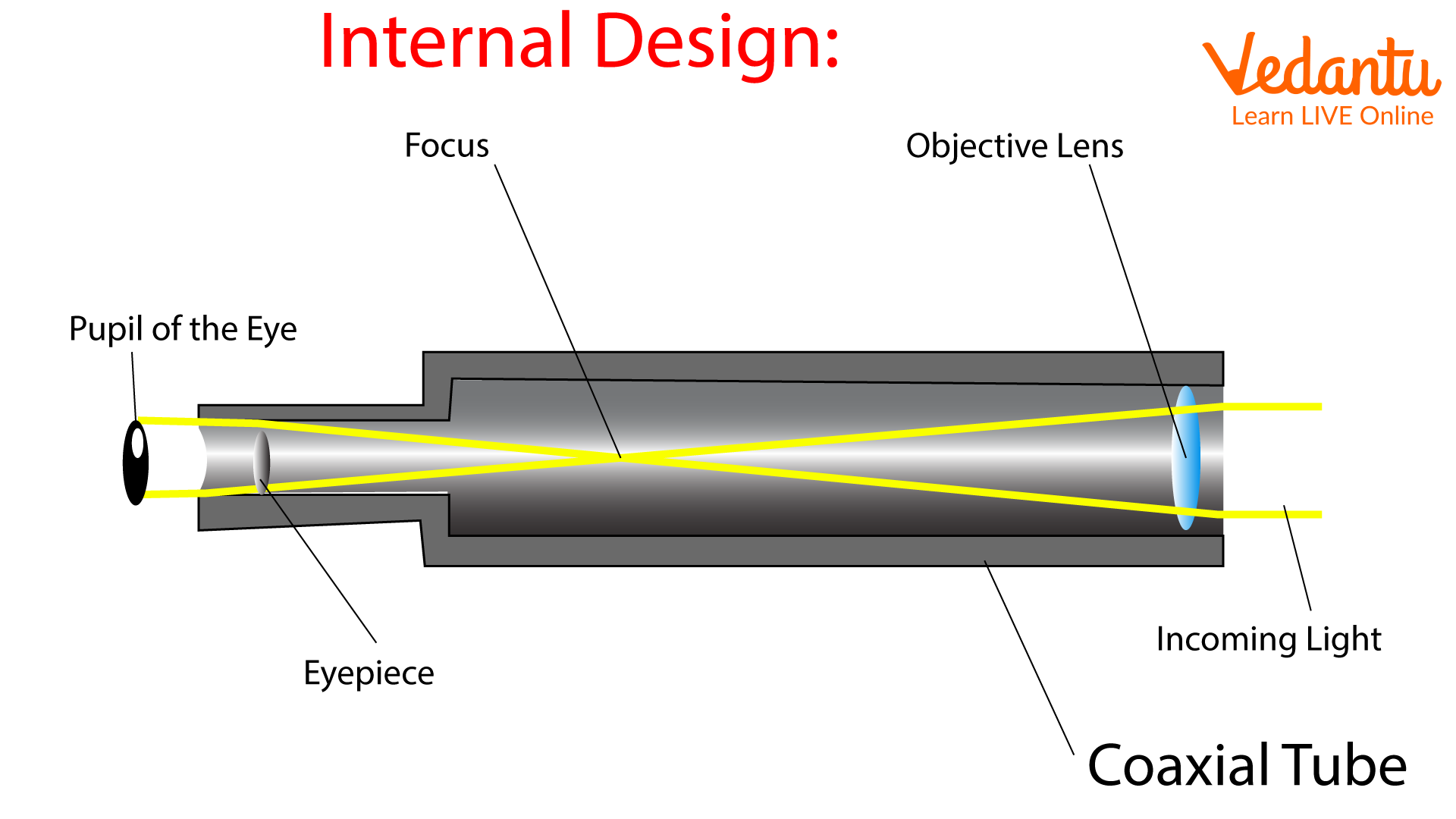



What are Telescopes?
In this article, we will learn about refracting telescopes. A telescope is an optical device in which light from distant objects is gathered and focused by lenses, curved mirrors, or a combination of both. There are two main types: refractive and reflective telescopes. Since the invention of telescopes, astronomers have been able to see new phenomena and objects by looking into the vast space.
Telescopes serve three main functions:
Telescopes are light collectors. The telescopes focus incoming light rays on a small area.
Resolution: Telescopes resolve incoming light so that finer details can be seen.
Magnification: making objects look bigger (closer to us).
Types of Telescopes
1. Refractive Telescope
A refracting telescope is an optical telescope that forms an image with a lens as its objective. The refracting telescope gets its name from the fact that it uses refracting elements, i.e., lenses. The two lenses used in a refracting telescope are the objective or primary lens, which is used to refract or bend the light to a focus point, and some type of eyepiece. These primary and eyepiece lenses are fixed at the ends of two coaxial tubes and parallel rays from a distant object enter the telescope. Refracting telescopes were the earliest telescopes to be devised.
The first record of a refracting telescope is in the Netherlands around 1608. A spectacle maker named Hans Lippershey from Middleburg tried to patent it but was unsuccessful. Then, this news spread like a wildfire which reached Galileo Galilei in May 1609 and he then constructed his own version and used it to make astronomical observations.
Examples: Yerkes Observatory (the largest refracting telescope ever built. Its main lens have 1.02 metres in diameter), James Lick telescope (91 cm in diameter).
2. Reflective Telescope
A reflecting telescope is an optical telescope that uses a mirror as its objective to form the image. The image is formed by reflecting the incoming light.
Examples: The Keck II telescope in Mauna Kea, Hawaii, Gran Telescopio Canarias in La Palma, Spain
Working Principle of Refracting Telescope
All the refracting telescopes are based on the same principle that we are about to discuss in this section. The objective lens and the eyepiece lens are used together to gather more light at a point than the human eye can collect. It then focuses the light and is presented to us with a brighter, clearer, and magnified virtual image.
The objective lens refracts the light and it causes parallel light rays from distant objects to converge at a focal point. The rays that are not parallel converge upon the focal plane. The image created at this focal point is real, inverted, and diminished. Now, this image cannot be used to observe distant objects and this is where the eyepiece lens comes into play. If the image formed is adjusted to be at the focal point of the eyepiece, the final image will be formed at infinity and the image is therefore highly magnified and erect.
Below is a schematic and a ray diagram of a refracting telescope which will help understand the principle of the refracting telescope in a better way. In the ray diagram, the parallel light rays coming through the objective lens are focused at the focal point of the lens. The image formed at this focal point is then adjusted to be at the focal point of the eyepiece which gives a magnified and better image. fo and fe are the focal lengths of the objective and the eyepiece lens, respectively.

Refracting telescope ray diagram

Refracting telescope schematic
Magnification Formula for Refracting Telescope
Any optical instrument's magnification is determined by how much larger the picture is as compared to the object. A refracting telescope’s magnification depends on the focal lengths of the lenses used in it that is the objective and the eyepiece.
A refracting telescope's magnification is determined by dividing the objective's focal length by the eyepiece's focal length. If M is the magnification of the refracting telescope, fo is the focal length of the objective, and fe is the focal length of the eyepiece, then the magnification is given as:
\[M=\frac{f_{o}}{f_{e}}\]
Since the magnification depends on the focal lengths, usually, astronomers have a variety of eyepieces on hand. When examining the Moon, for example, you don't always want an exceedingly high magnification. Changing eyepieces is common when trying to observe a star.
Types of Refracting Telescopes
1. Galilean telescope: This telescope was invented by Galileo Galilei in 1609. In this type of telescope, the objective and eyepiece lenses are convergent and divergent, respectively.
2. Keplerian telescope: The Keplerian telescope was invented by Johannes Kepler in 1611. This is an improved version of the Galilean telescope.
3. Achromatic telescope: This telescope is designed to fix the major drawback of refracting telescopes, the chromatic aberration. This type was first invented by an English barrister named Chester Moore Hall in 1733. The achromatic lens is used in this type. The achromatic lens is used to bring two different wavelengths into the focus points in the same plane. The two wavelengths are red and blue.
4. Apochromatic telescope: The apochromatic lens is used in this type. The achromatic lens is used to bring three different wavelengths into the focus points in the same plane. The three wavelengths are red, blue, and green.
Advantages and Disadvantages of Refracting Telescopes
Advantages
Higher revolving power per inch of aperture.
No interruption of the light path.
Near permanent optical alignment - minimum maintenance needed.
Disadvantages
Chromatic Aberration: The failure of a lens to concentrate all colours to the same point is known as chromatic aberration. Chromatic aberration affects only refractive telescopes. When light is refracted through glass, then shorter wavelengths bend more than longer wavelengths and blue light comes closer than red light. For example, if we focus the eyepiece on the blue light, then the red light is out of focus which produces a red blur around the image and vice versa. The chromatic aberration can be minimised by using achromatic lenses. Chromatic aberration can be reduced (~10 times) by a multiple lens system.
Very high initial cost as compared to the reflector.
The objective lens has to be supported at the edges, and they sag under their own weight.
To achieve a large focal length, the telescope will be long and requires massive support and domes.
In the glass, light is absorbed and scattered.
The lens of large size are difficult to make, and they always have errors.
Conclusion
Telescopes are more of an eyeglass maker's triumph than a scientist's innovation. Telescope observations demonstrated that the Earth is not the centre of the universe, as was a hotly debated matter during the Galilean era, and that the Solar System is made up of multiple planets and their satellites. Greater telescopes are being manufactured for better views, and the optics are continually being updated.
A telescope is an optical device in which light from distant objects is gathered and focused by lenses, curved mirrors, or a combination of both. Refractive and reflective telescopes are the two main types of telescopes. A refracting telescope is an optical telescope that uses a lens as its objective to form the image whereas a refracting telescope is an optical telescope that uses a mirror as its objective to form the image.


















FAQs on Refracting Telescope and Its Types - JEE Important Topic
1. Why is the reflecting telescope largely used in space research instead of the refracting telescope?
Most astronomical telescopes are reflectors. A reflecting telescope uses an objective mirror and objective lenses are used in refractive telescopes. Objective mirrors are easier to make than objective lenses. Large mirrors are structurally easier to design and less expensive to build than large lenses. Mirrors don't have to be made of glass; they can also be constructed of metal or layers. They must be flawless on one side alone, not both. Mirrors are just less expensive and easier to produce, particularly in the diameters required for modern telescopes.
2. For what purposes is the refractive telescope used?
The refractive telescopes are typically used to examine the Moon and other objects of the solar system. For astrophotography, a refractive telescope is a better option. Refractive telescopes are used for terrestrial viewing. Most of the early discoveries of the Solar System were made with singlet refractor telescopes. The refracting telescope optics are largely used in Earth orbits to take photographs. Galileo himself used a refractive telescope to discover the largest moons of Jupiter in 1609.




